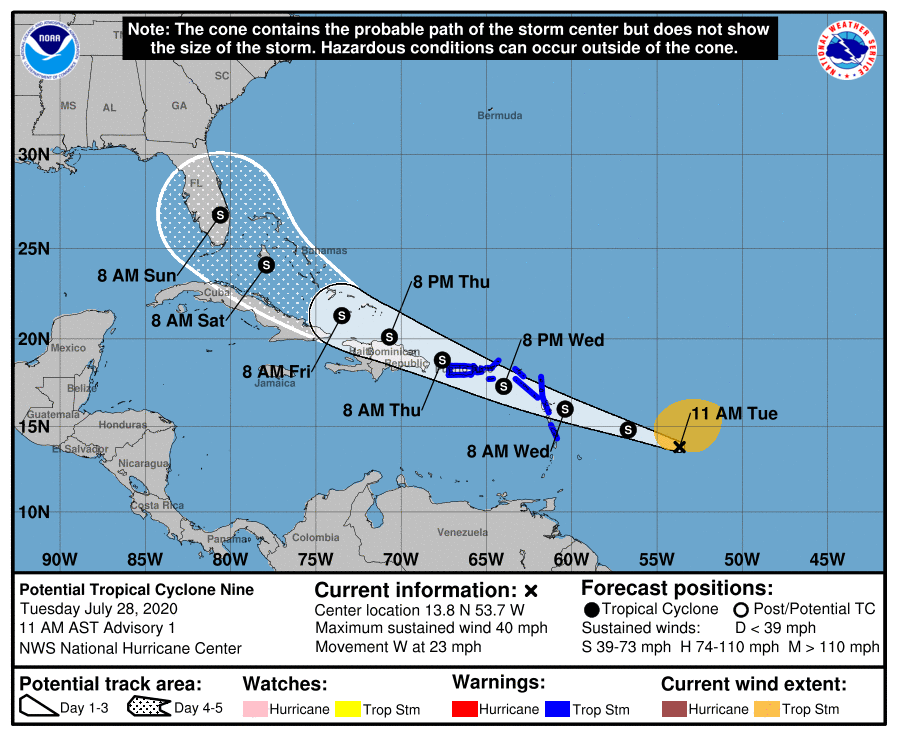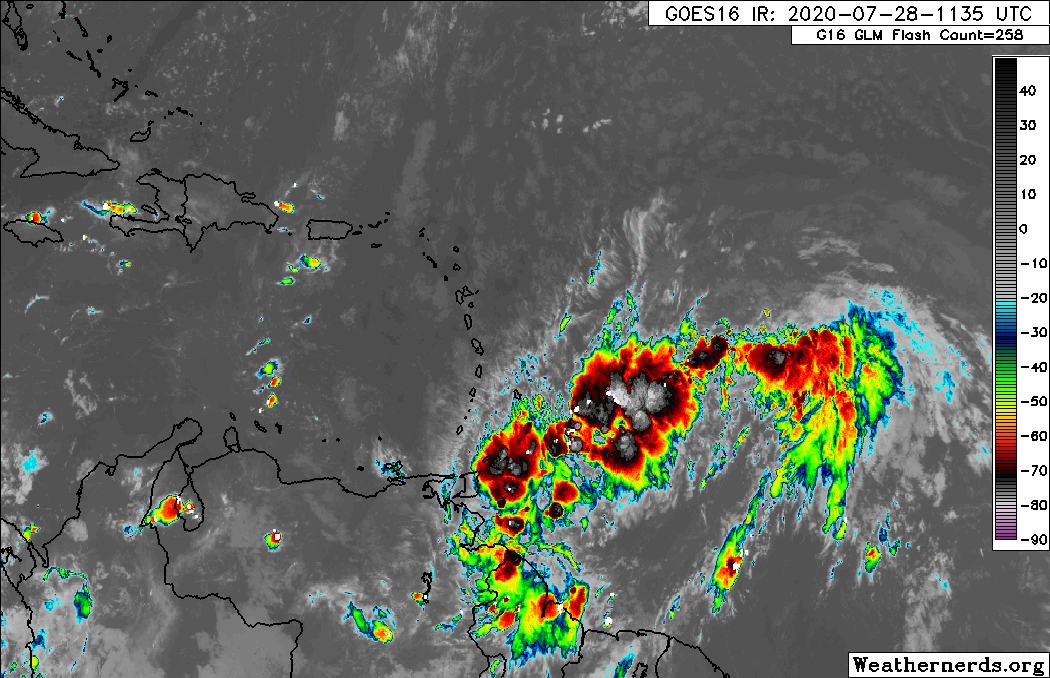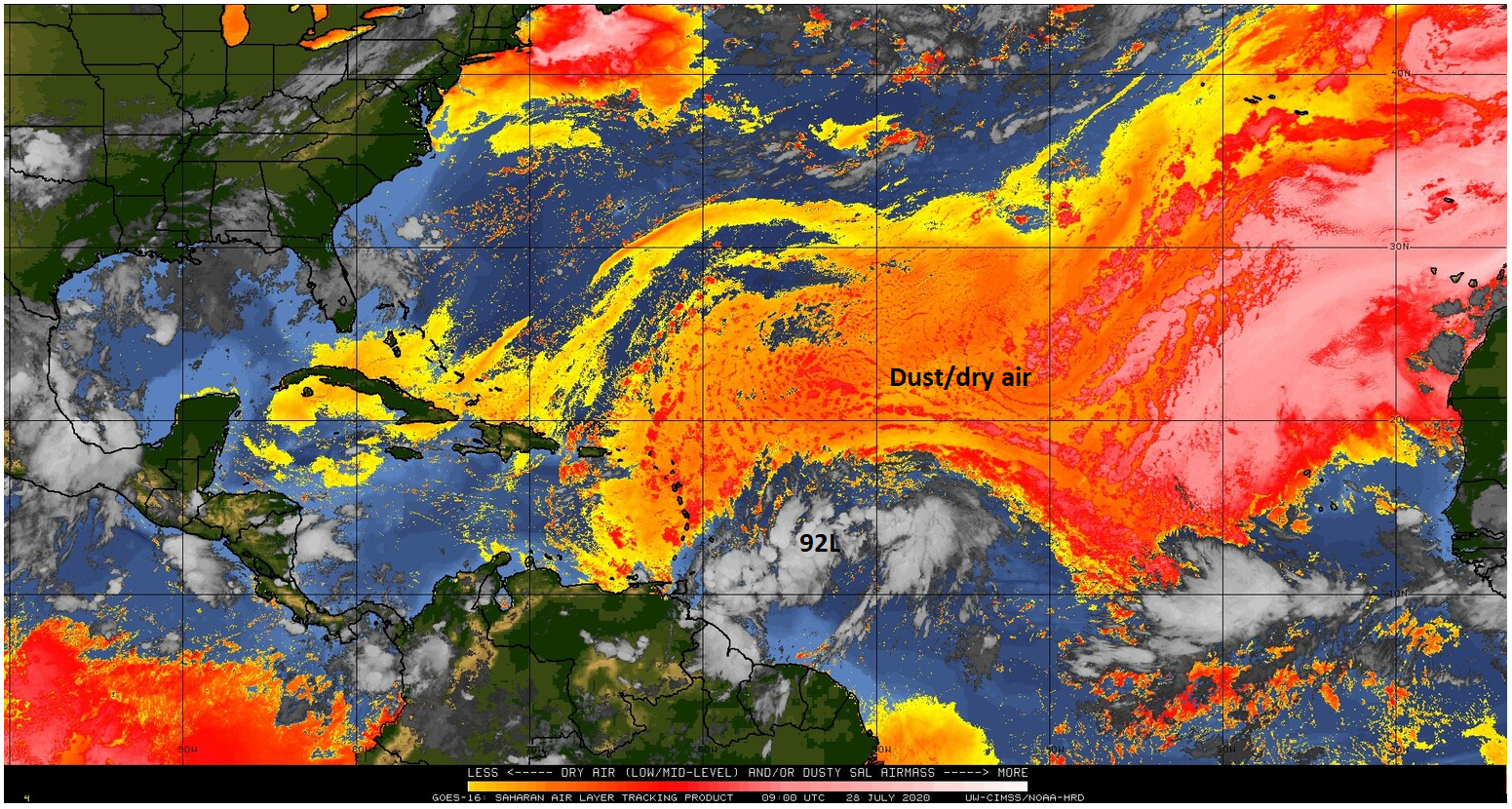With Hurricane Hanna behind us, the obvious question is, “What’s next?” We have one system at present to watch, and then the situation gets a little trickier to figure out.
Tropical outlook in a sentence
The disturbance just dubbed “Potential Tropical Cyclone 9” by the National Hurricane Center is the one we are watching for development this week. Although we do not expect an especially strong system, it is still far too early in the game to dismiss any scenario or track.
PTC #9
The road forward on where Potential Tropical Cyclone 9 goes and what it does is a long one, and we are still at the beginning. Possibilities range from no impact at all on the United States to an impact on the Gulf, US East Coast, or something in between. Basically, everything. That’s a less than helpful forecast, but it’s the only realistic one that can be offered right now. The National Hurricane Center’s designation of this disturbance as a “potential tropical cyclone” means it has confidence a depression or storm will develop and impact land soon. They will initiate advisories on this system this morning, which will allow for watches and warnings to be issued for Caribbean islands. Their first forecast is below.

From their technical discussion, it’s worth noting that there is a very high degree of uncertainty. As they note:
It cannot be stressed enough that since the system is still in the formative stage, greater than average uncertainty exists regarding both the short-term and longer-term track and intensity forecasts.
PTC 9 has some hurdles ahead. A look at the satellite image from this morning shows a lot of “stuff,” but not a lot of healthy organization right now.

That shouldn’t minimize it as something to watch, but given how things have gone in recent years, it’s nice to see a disturbance struggling to organize. One of PTC 9’s problems is that it has a large size. It’s a lot easier to spin up a smaller system that grows, but this one covers a large chunk of real estate already, so to get it started requires some effort. The other problem is that there are multiple clusters of thunderstorms within the broader circulation, any of which could become dominant. That obviously has implications on the long-term track.
The disturbance is also surrounded by a lot of dust and dry air.

The problem here from a forecast standpoint is that since we don’t know where in this broad circulation the thunderstorms will consolidate to help develop a defined tropical depression or storm. we cannot quite give you a definitive starting point. Without a solid starting point, forecast accuracy 3, 5, or 7 days from now will obviously suffer.
What we can tell you is that PTC 9 has hurdles in front of it. Between the dry air, a likely encounter with a weak trough in the Bahamas Friday, and another, stronger trough over the Southern U.S. next week, as well as any land interaction on its way west, it will need to overcome some challenges and insulate itself from these threats or else it will struggle to develop.
That said, anything from where the system consolidates to how strong these troughs and other features actually are (compared to what they’re currently forecast to be) could impact where PTC 9 goes and how strong it is. For now, the best advice with this system is to not worry about it (we’re certainly not), but check back in on it every day or two to see what has changed.
And for those of you wondering, if we do get a storm out of this one, it will be named Isaias, and pronounced:
Here you go! I got y’all! 🤜🤛@sbowerswx @wxbrad https://t.co/Ca27uLAc3A pic.twitter.com/WzrruUnkVd
— Irene Sans (@IreneSans) July 26, 2020
Beyond Isaias
Things get complicated beyond PTC 9/Isaias. Intriguingly, there are no other systems showing up on the models with any frequency or confidence right now. This is implying that we may enter a quiet stretch for a time again. There’s some background support for this as a feature that typically helps suppress storm development should move through the Atlantic Basin this week. On the flip side, the 2020 M.O. has been for random stuff to flare up seemingly out of nowhere. So in that sense, it’s tough to argue a quiet period.
Whatever the case, I do think we will have a slightly quieter stretch post-Isaias, with the risk of a more significant ramp up in activity by the middle or late portion of August.
What happened to Gonzalo that was heading towards South America before I got distracted by Hanna?
Dissipated and most of its moisture/energy ended up in either South America or Panama or Costa Rica. It was way too far south to have much of a chance.
Since you are “Space City Weather,” please tell us what impacts this storm may have on the SpaceX splashdown scheduled for Sunday!! 🙂
My distant cousin is on the backup SAR crew; he says they have been considering landing sites in both the Gulf and the Atlantic. I’m thinking that a large-area storm running up the middle of Florida could cause problems on both sides.
What is the “feature that typically helps suppress storm development?”
A suppressed Kelvin wave…can lead to basically less large scale vertical motion necessary to trigger storms/waves. This is also coinciding with a pretty unfavorable convective pattern in the tropics (via what we call the MJO), with the bulk of the support for storminess expected to be in the Indian Ocean or Western Pacific the next 2 weeks.